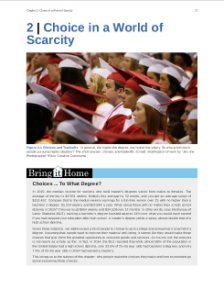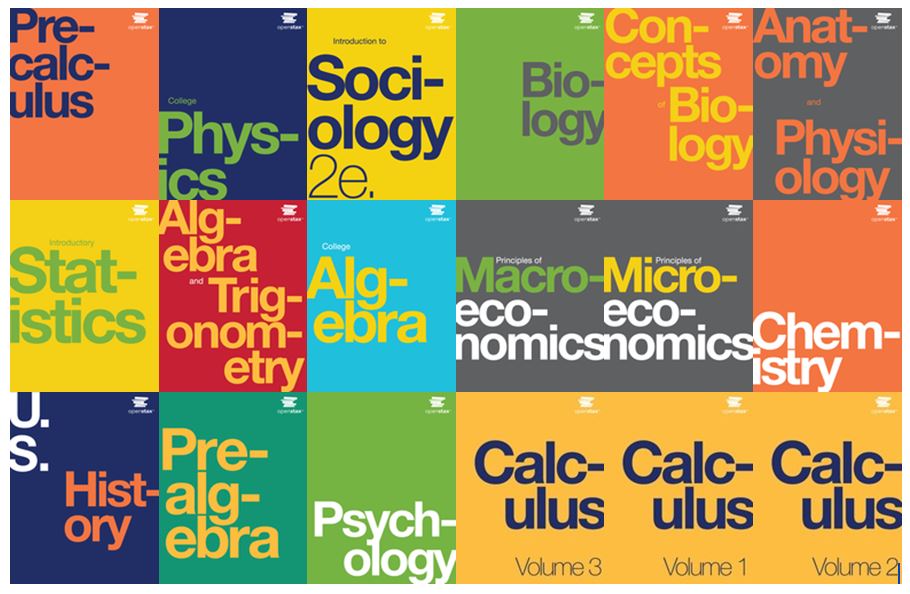Free Online Textbooks: Potential Cost Savings and Academic Impacts
By Art Grinath and Bruce Madariaga
Introduction
As the cost of hard-copy college textbooks continues to rise, calls from students and administrators for professors to instead adopt free or low-cost online course materials have risen in volume. Understandably, many instructors have resisted such calls, not wanting to adopt uncoordinated and incomplete collections of online material that may at some point become inaccessible or at the least require substantial maintenance. But now, entirely free, peer reviewed, and modifiable textbooks, such as those offered by “Openstax”, are available for various college principles courses. The adoption of these online textbooks can result in substantial costs savings for students and could result in increased enrollment, but are these books as academically effective as their hard-copy counterparts?
This paper reports on an experiment performed within the principles of economics courses offered at the Germantown Campus  of Montgomery College (MC) to assess the cost savings and academic impacts of switching from a leading hard copy economics textbook to the free Openstax Principles of Economics textbook.
of Montgomery College (MC) to assess the cost savings and academic impacts of switching from a leading hard copy economics textbook to the free Openstax Principles of Economics textbook.
The Openstax Project
 Openstax College is a non-profit initiated at Rice University and supported by various other innovation promoting non-profits such as the Gates Foundation. Openstax provides entirely free, downloadable, extensively peer reviewed, and entirely customizable (no copyright difficulties[1]) college principles textbooks. Openstax also provides supplemental material for instructors and the option for students to purchase hard copies of their books,
Openstax College is a non-profit initiated at Rice University and supported by various other innovation promoting non-profits such as the Gates Foundation. Openstax provides entirely free, downloadable, extensively peer reviewed, and entirely customizable (no copyright difficulties[1]) college principles textbooks. Openstax also provides supplemental material for instructors and the option for students to purchase hard copies of their books,
typically for approximately $40.
[1] Openstax books are licensed under a Creative Commons Attribution 4.0 International License
The list and use of Openstax textbooks continues to grow. In addition to Principles of Economics, Openstax currently offers 18 books spanning 10 different disciplines: https://openstaxcollege.org/books. Openstax reports that roughly 2500 courses and 400,000 college students are using Openstax books.
Study Approach
The Economics faculty at the Germantown Campus of MC became interested in adopting the Openstax Economics textbook in 2015. However, before making a long term commitment to the Openstax text, we sought evidence that switching to an online book would not have adverse academic impacts. Thus, in the Spring and Fall 2015 semesters, we conducted an experiment.
To estimate student cost savings and the academic impacts associated with switching to the free Openstax online economics textbook, we surveyed our students twice. The first survey was administered at the end of the spring 2015 semester when students were still required to use the traditional textbook that we had been using at Germantown for several years – Principles of Economics by Gregory Mankiw. This book is one of the most adopted textbooks for college-level principles of economics courses nationwide. The second survey was administered at the end of the fall 2015 semester after the change to the Openstax book. The Openstax Economics textbook covers virtually the same content as other principles of economics textbooks, including the Mankiw textbook. The numbers of students responding to the spring and fall semester surveys were 209 and 211, respectively.
When implementing the survey, we explained the purpose of the survey to our students and assured our students that their responses would be entirely confidential. (Students were instructed to not include their names on the survey, and instructors left the classroom during completion of the survey.)
Readers interested in reviewing the fall and spring 2015 surveys employed in this study may contact the authors.
Results
Our survey results are presented in Table 1.
_____________________________________________________________________
Table 1. Survey Results: Academic Impacts [1]
| Traditional Textbook | Openstax Textbook | |
| % of Students who Found their Book “Very Useful” or “Useful” | 65 | 75 [2] |
| % of Students who Downloaded Electronic Version | NA | 71 |
| % of Students who Obtained a Hardcopy Version | 89 | 29 |
| % of Students who Obtained a Book | 89 | 93 |
| % of Students who Did No Reading | 14 | 9 |
| Avg % of Assigned Readings Read | 49 | 57 [3] |
| Avg Hours Spent Reading Per Week | 2.41 | 2.43 [4] |
- [1] Students were given categories for the survey. Categories were converted to values for the purposes of calculating averages. Calculation details can be obtained from the authors.
- [2] The average difference in “usefulness” was statistically significant at the 99% confidence level.
- [3] The average difference in “% of assigned readings” was statistically significant at the 95% confidence level.
- [4] The average difference in “hours spent reading” was not significant at the 95% confidence level.
______________________________________________________________________
The major findings from our survey are that after switching to the Openstax textbook students:
- Rated the Openstax book significantly more useful than the traditional book we were using,
- Read a significantly higher percentage of required readings, and
- Read slightly more time per week.
Meanwhile, the change to the Openstax book saved Germantown’s economics students about $120 per student or roughly $25,000 in total during the fall 2015 semester.[5] Extrapolating from this, we estimate that when all MC ECON 201 and ECON 202 classes adopt the Openstax book (scheduled to begin during the Fall 16 semester), the savings to our students will equal roughly $165,000 annually. If all MC disciplines adopted Openstax books, the savings to students would likely be in the millions of dollars annually.
Observations and Qualifications
Our survey results provide evidence that switching to a free online textbook may have positive academic impacts and substantial cost savings for students. But our results should not be viewed as conclusive for at least a few reasons.
First, the reason why students rated the Openstax book more highly may be related to convenience rather than academic superiority. At present, we have not attempted to measure the impact of the Openstax textbook on academic outcomes. The Openstax textbook may not be a better learning tool. It may just be more convenient and receive the “halo effect” of being free. Of course, if students are more likely to complete the required readings (as students reported) because of convenience and price, improved academic outcomes are likely to result.
Secondly, the courses and instructors offered during the Fall 2015 and Spring 2015 semesters were similar but not identical. Thus, the two surveys have approximately the same number of responses, but represent a slightly different mix of instructors and courses. As a result, some of the differences between the traditional textbook and the Openstax textbook may reflect different sample groups, although we have no reason to believe that this biases our results in either direction.
Lastly, our per-student and thus aggregate cost savings estimates may be overstated. We have not accounted for any money students might receive from resale of their textbook. We also have not factored in the cost to students who decided to get a hardcopy of the Openstax book even though the on-line version is free. If the 29% of students that spent approximately $40 on the hard copy version of the Openstax textbook are factored in to our calculations, our fall semester cost savings estimate for students at MC Germantown would fall from $25,000 to roughly $23,000.
On the other hand, our aggregate cost savings estimate may be understated. Both the traditional and the Openstax economics textbooks cover both ECON 201 and ECON 202 courses. To estimate aggregate savings at the Germantown campus during the fall 2015 semester, we multiplied our cost savings estimate per student ($120) times enrollment in ECON 201 only (since students taking ECON 202 usually have already taken ECON 201 and thus do not have an additional textbook cost when taking ECON 202). However, a (relatively small) fraction of students enroll only in ECON 202. The cost savings to these students are not captured by our estimates.
Conclusion and Recommendation
Despite the limitations of our survey results, these findings suggest that other disciplines at MC, as well as disciplines within community colleges and universities nationwide, should consider the Openstax textbook option. We owe it to our students to reduce their educational costs when feasible, especially when evidence suggests that the academic impacts of doing so are not negative and may be positive.


